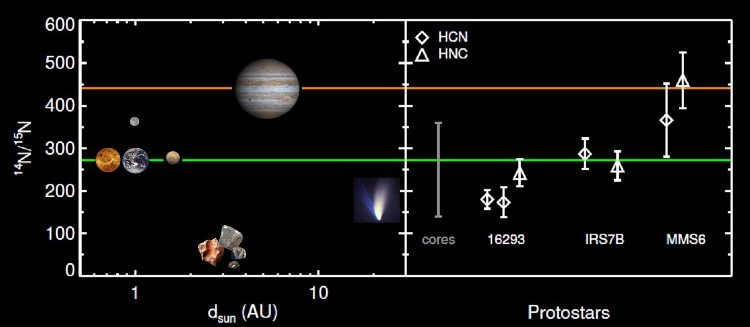| EPoS Contribution |
|
Nitrogen isotope fractionation in Class 0 protostars
Susanne Wampfler StarPlan/NBI, Copenhagen, DK | |
|
The large isotopic anomalies among the Solar System bodies in volatiles like hydrogen, oxygen, and nitrogen are peculiar, because the Solar System's isotopic composition in other elements is much more homogeneous. The solid Solar System bodies, i.e. the terrestrial planets, comets, and meteorites, are substantially enriched in heavy nitrogen (15N) compared to the Sun and Jupiter, whose 14N/15N ratio is believed to reflect the composition of the presolar nebula.
Various scenarios have been proposed to explain the nitrogen isotope heterogeneity of the Solar System, the two currently favored being chemical fractionation and isotope selective photo-dissociation. However, what process has caused the Solar System variations could not yet be determined, because measurements of the nitrogen isotope composition in active star-forming regions to compare with are scarce. Previous studies, which mainly focused on prestellar cores, revealed that nitrogen isotope fractionation occurs in prestellar cores, but it is unclear how the isotopic composition evolves when a protostar forms. In this contribution, we present measurements of the 14N/15N ratio in three nearby low- and intermediate-mass Class 0 young stellar objects, based on observations of HCN and HNC isotopologues with the APEX telescope. We find evidence for nitrogen isotope fractionation in HCN and HNC for at least two of the Class 0 sources in our sample. A tentative trend of a decreasing 15N-enrichment with increasing outer envelope temperature hints at the most likely scenario being chemical fractionation. To help distinguishing between the two scenarios, spatially resolved observations are needed to probe spatial variations in the nitrogen isotope composition. Interferometric observations of a Class 0 young stellar object with the Plateau de Bure Interferometer have just been completed and we will also present the first results of this study. | |
 | |
| Caption: Left panel: Illustration of the 15N-anomaly of the Solar System. Solids are significantly enriched in 15N compared to the Sun and Jupiter. Right panel: 14N/15N ratios measured from our APEX observations of three protostars. HCN and HNC in two of the Class 0 sources are clearly enriched in 15N. The results are consistent with typical prestellar core values, indicated by the gray bar. For the third source, the uncertainties are larger and a Solar composition cannot be excluded. | |
| Collaborators: J.K. Jorgensen, NBI/StarPlan, Denmark S.E. Bisschop, StarPlan/NBI, Denmark M. Bizzarro, StarPlan, Denmark |
Suggested Session:
Chemistry |

